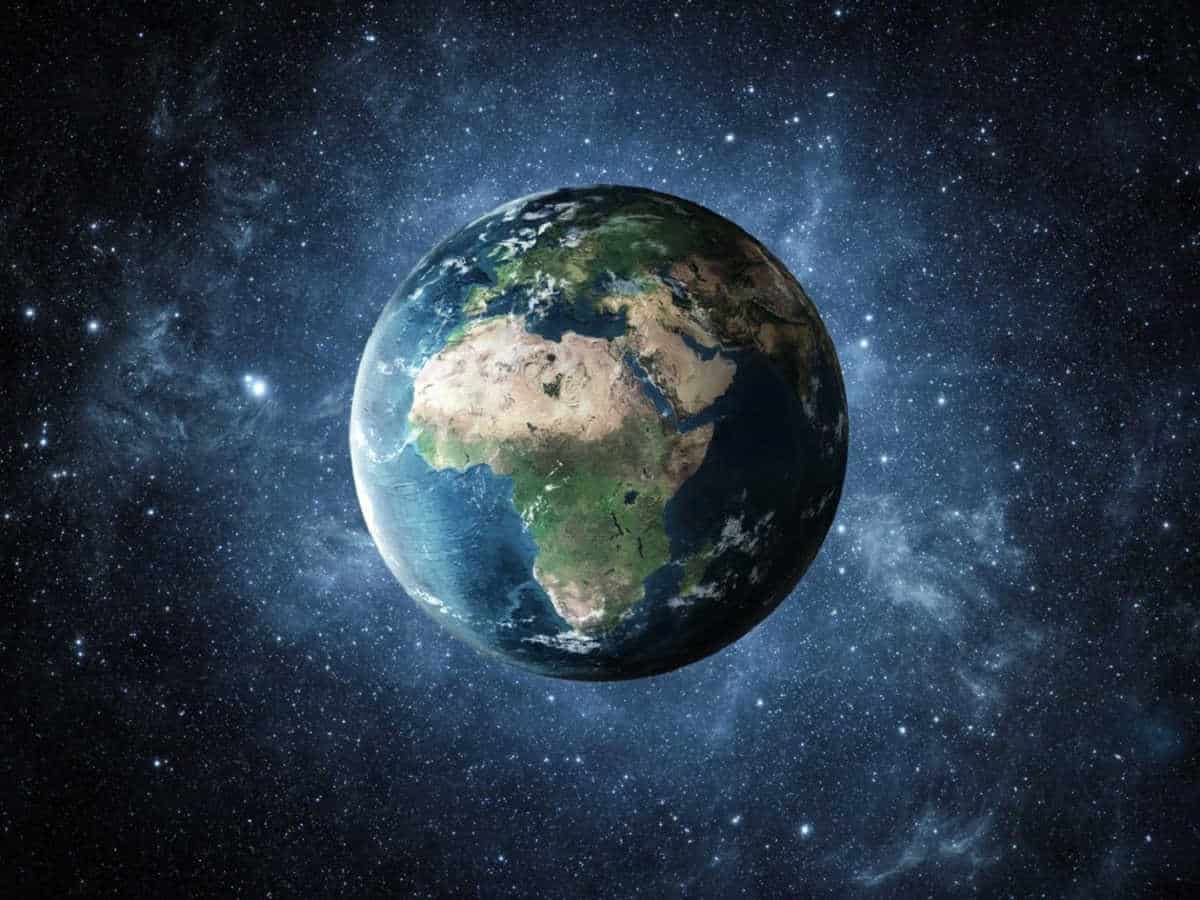
The mass of our planet Earth has been a subject of study and exploration by scientists throughout history. One of the most intriguing aspects of our planet is its mass, which cannot be directly measured. Instead, scientists have developed various methods of indirect measurement.
Therefore, in this article, we will provide you with comprehensive information about the mass of the Earth, including how scientists have been able to calculate it and the unique characteristics it possesses.
Characteristics of Planet Earth
Planet Earth is a unique celestial body that stands out for its remarkable characteristics. It is the third planet from the Sun and is known for being the only planet in the solar system that supports life. Besides its ability to sustain life, Earth has a variety of other notable features.
One of the distinguishing characteristics of Earth is its diverse ecosystems. From lush rainforests to vast deserts, the planet is home to an incredible array of plant and animal species. This biodiversity is crucial for maintaining the delicate balance of our planet’s ecosystems.
Another important characteristic of Earth is its atmosphere. Composed mostly of nitrogen and oxygen, the atmosphere plays a vital role in supporting life on the planet. It protects us from harmful solar radiation and provides us with the air we breathe.
The Earth’s geology is also something to marvel at. The planet is made up of several layers, including the solid inner core, the molten outer core, the mantle, and the crust. These layers interact with each other and contribute to various geological phenomena such as earthquakes and volcanic eruptions.
Lastly, Earth is unique in its ability to sustain liquid water on its surface. Water is essential for life as we know it, and Earth’s abundance of this vital resource sets it apart from other planets in our solar system.
In conclusion, Planet Earth is a remarkable celestial body with a myriad of unique characteristics. From its diverse ecosystems to its protective atmosphere, Earth provides a habitat for countless species and is a truly special place in the universe.
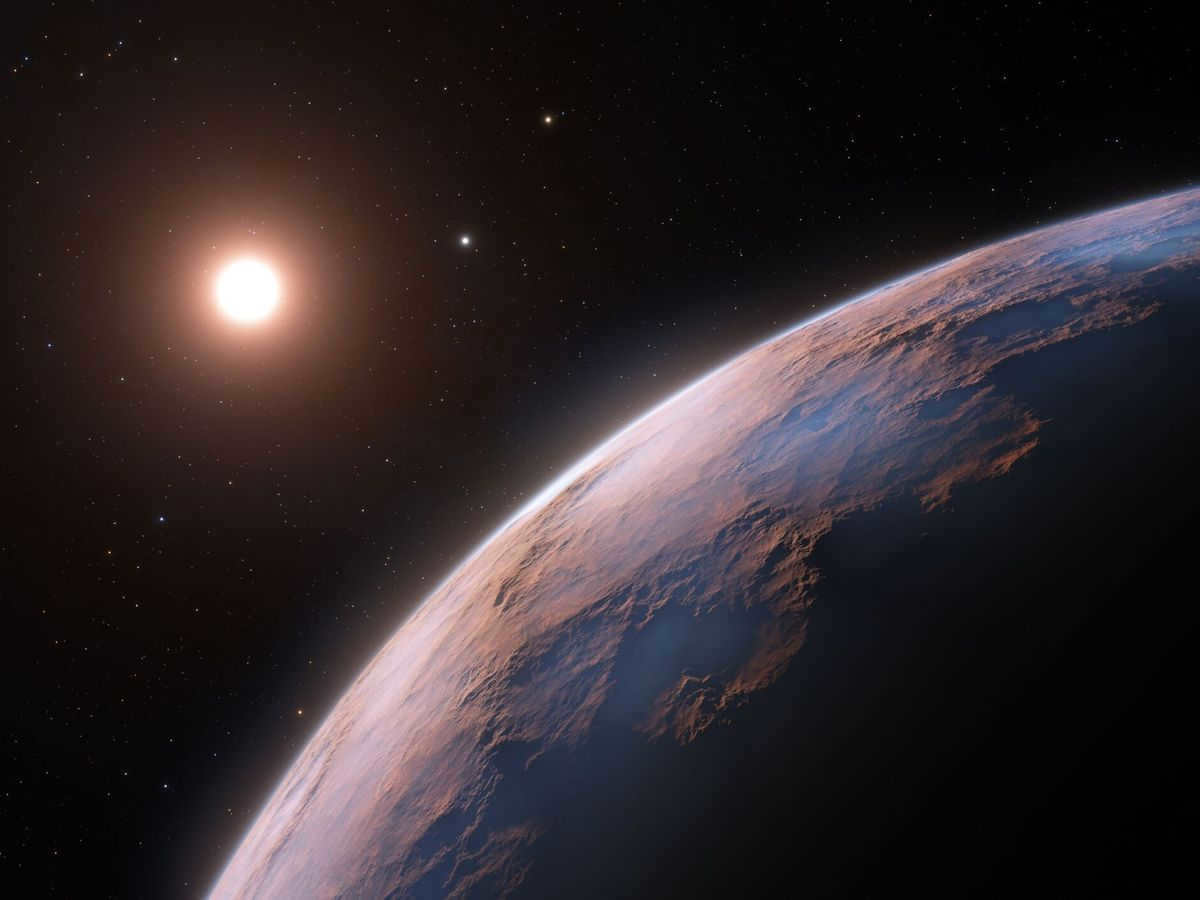
Situated between Venus and Mars, Earth is the third planet in our solar system. It is the only known planet in the universe to support life. The name “Earth” is derived from the Latin word “Terra,” which is associated with the Roman god and the ancient Greek goddess Gaia, symbolizing fertility and abundance. Often referred to as Tellus mater or Terra mater (Mother Earth), this planet is considered the source of all life.
Throughout history, humanity has harbored a fascination with uncovering the boundaries of our planet and venturing into its most remote reaches. Ancient societies held the belief that the earth was boundless or potentially teetered on the precipice of an abyss. Even today, there exist individuals who maintain the notion that the earth is flat, hollow, or subscribe to other conspiracy theories.
Nonetheless, the wonders of science and technology have bestowed upon us breathtaking imagery of our planet. We have also gained insights into its geological composition and the state of affairs prior to the emergence of human civilization.
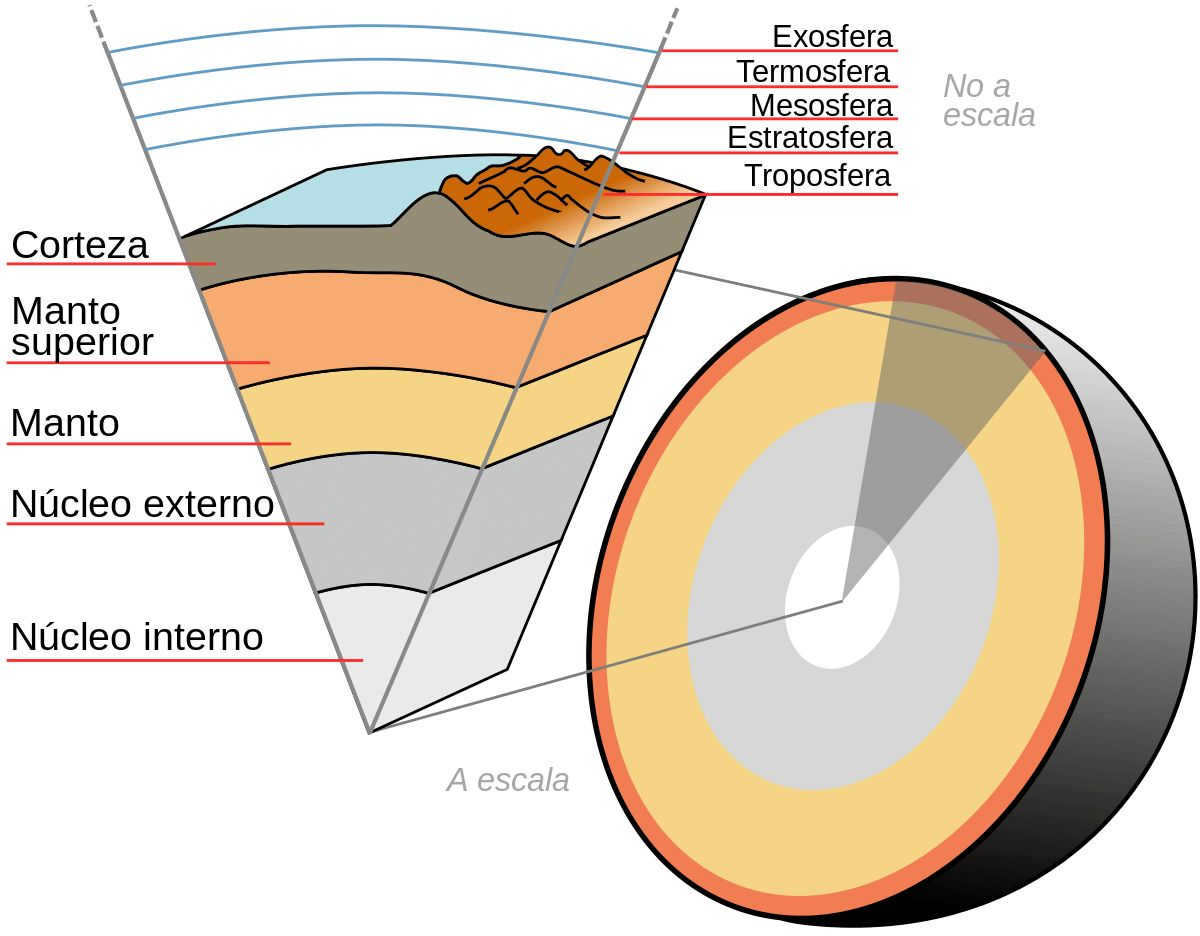
Approximately 4,550 billion years ago, the Earth came into existence from the same material that forms the rest of the solar system. Initially, it started as a stellar cloud consisting of gas and cosmic dust. It took around 10 to 20 million years for the planet to take shape, with gas clouds forming around it as the surface cooled, eventually creating the atmosphere we have today.
Through a series of seismic activities that lasted for an extended period, potentially influenced by meteor impacts, the Earth acquired the necessary elements and physical conditions for liquid water to emerge.
As a result, a hydrologic cycle was initiated, aiding in the planet’s faster cooling to a level suitable for the emergence of life. Over time, the abundance of liquid water on the surface gives our planet a blue appearance when observed from space.
Mass of Earth
Earth is the fifth largest planet in the solar system and the only one capable of sustaining life. It has a spherical shape with slightly flattened poles and a diameter of 12,756 6,378.1 km at the equator (radius of 6,378.1 km at the equator). It has a mass of 5.9736 x 10^24 kg and a density of 5.515 g/cm3, which is the highest among all the planets in the solar system. Additionally, it has a gravitational acceleration of 9.780327 m/s^2.
Similar to other inner planets like Mars and Mercury, Earth is a rocky planet with a solid surface and a liquid metallic core (caused by the heat and pressure from its own gravity), in contrast to the gas giants like Venus or Jupiter. Its surface is composed of a gaseous atmosphere, a liquid hydrosphere, and a solid geosphere.
What was the method used to calculate the mass of the Earth?
Calculating the mass of the Earth was not as simple as putting the planet in equilibrium. Instead, scientists used the Cavendish scale, named after the scientist who first accurately measured the Earth’s mass.
This groundbreaking measurement took place in 1798, 113 years after Isaac Newton formulated his law of universal gravitation in 1685. Even earlier, in 1609, Galileo used a telescope to observe the sky. However, it’s remarkable that Henry Cavendish was able to determine the mass of the Earth without even leaving his home.
In reality, he had just escaped the forest. East Cavendish he was a gloomy, temperamental, and eccentric individual, yet an exceptional one. In principle, it commences with Newton’s LGU, which states that “every two entities, regarded as point masses, are drawn towards one another by a force that is directly influenced by their masses multiplied by an unidentified constant, now recognized as the gravitational constant . . . . This constant is inversely related to the square of the Newtonian distance between them.”
Measurement Units and Fixed Values
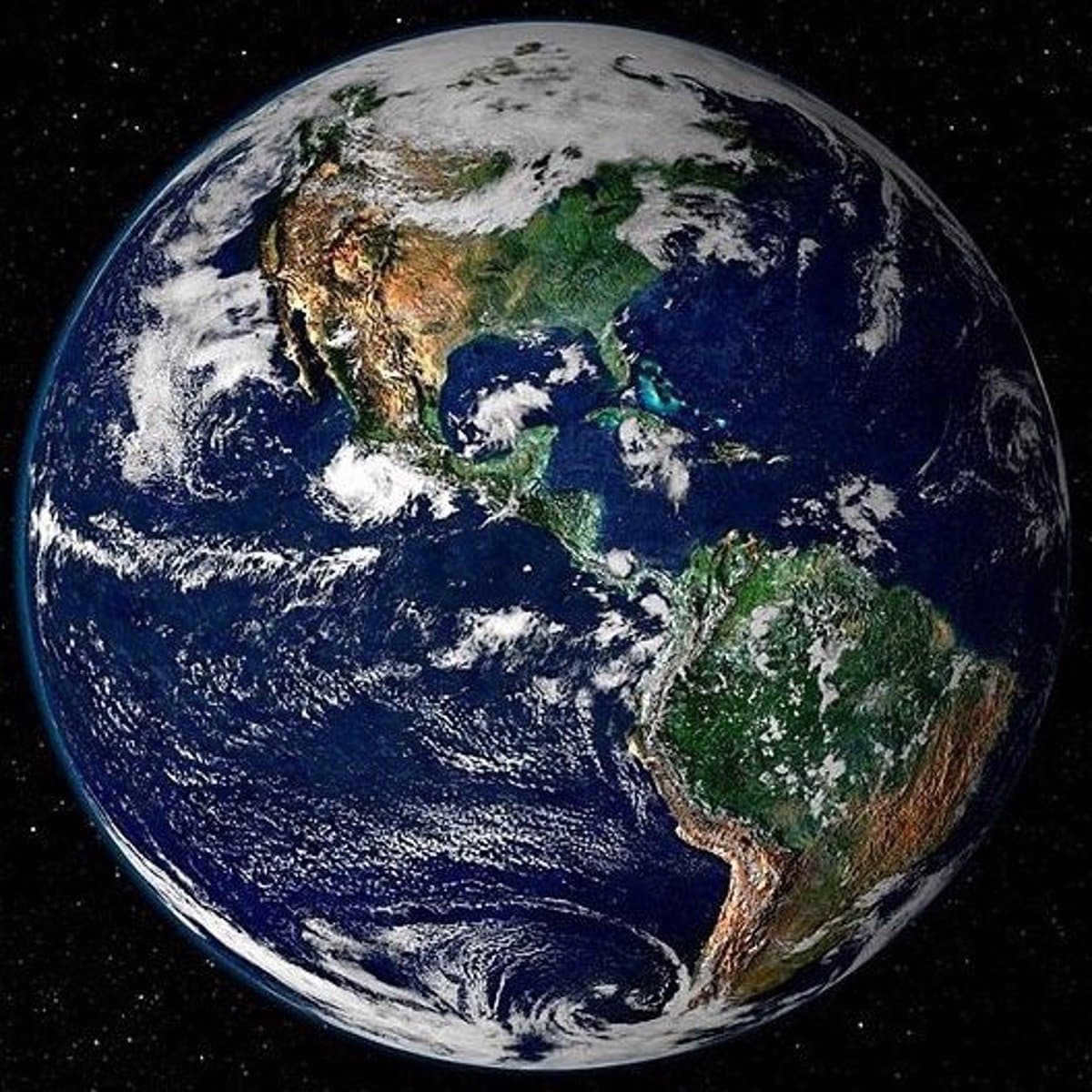
The apparatus consists of a pair of lead spheres, each with a diameter of 30 centimeters, that are suspended from a steel structure. Additionally, there are two smaller spheres measuring 5 centimeters in diameter that are suspended near the larger spheres and connected to each other by thin copper wires.
Essentially, torsion scales are designed to measure the rotational motion induced in the wires by the gravitational attraction between the larger spheres and the smaller spheres as the former move above the latter.
The issue lies in the fact that gravity is of such minuscule magnitude that any unexpected factor can distort the findings. That is precisely why Cavendish conducted the experiment remotely. To ensure that the presence of the researchers didn’t disrupt the setup, he employed an outdoor telescope. He utilized this device to observe a precise scale that was illuminated by a narrow beam of light originating from outside the room.
We are dealing with a level of sensitivity on the order of 0.025cm, which is quite impressive. It is an exceedingly delicate experiment. As anticipated, the small ball began to rotate, drawn towards the larger ball. After performing several calculations, Cavendish successfully determined the gravitational constant based on their masses and vibrations. This represents the initial stage, which is then followed by ascertaining the average density of the Earth, and subsequently determining the Earth’s mass to calculate the gravitational constant G.
I trust that this information will expand your knowledge on the Earth’s mass and its characteristics.
The content of this article adheres to our editorial ethics guidelines. To notify us of any errors, please click here.
Full Article Summary: Network Meteorology “Meteorology” Science “Earth’s Weight“
The Earth’s weight is approximately 6 sextillion tons (60000000000000000000000000000000000000000000000000 tons).
The Earth’s mass was initially calculated by Dr. Nevil MacEllyn from Perthshire in Scotland in 1774. Our planet weighs (prepare to count zeros!) 5879000000000000000000000000000000000000000000 tons.
However, each year the Earth becomes increasingly heavier: it accumulates about thirty thousand tons of space dust annually. Poor thing, it’s all covered in dust!
Because the Earth is suspended in space, determining its weight is not the same as placing an object on a scale. When we discuss the weight of the Earth, we are actually referring to its mass, which is the amount of matter it contains.
Currently, the Earth’s mass is approximately 5.976 sextillion tons. To provide a visual representation of this enormous number, it can be written as 5 976 000 000 000 000 000 000. But how did scientists arrive at this precise measurement?
To accomplish this, scientists utilized a principle based on the attraction between two bodies, which also determines the strength of gravity. In simple terms, the law of gravity states that two bodies are drawn towards each other with a force that is dependent on their respective masses and the distance separating them.
The force that attracts larger objects to each other is greater, while the force decreases as the objects move farther apart.
To determine the weight of the Earth, you can follow these steps: hang a small weight from a string and measure its precise position. Then, place a ton of lead next to the suspended weight. The lead will attract the weight, causing it to deflect slightly to the side. (The deflection is actually less than 0.000 02 mm, highlighting the need for precise measurement.)
Once scientists have taken these measurements, they are able to utilize mathematical calculations to determine the Earth’s weight. They have assessed the Earth’s gravitational strength in relation to weight, as well as the force exerted by a ton of lead on a suspended weight. By calculating the relative difference between these measurements, they can ascertain the mass of the Earth.
What contributes to this mass? It encompasses the solid rock crust, followed by a layer known as the mantle, which is also composed of solid rock and extends 2,880 km below the surface. Beyond that lies the innermost region, the core, with a radius of approximately 3,360 km. The core exists in a liquid state due to the intense heat at the Earth’s center.

What amount of water is needed to put out the Sun?
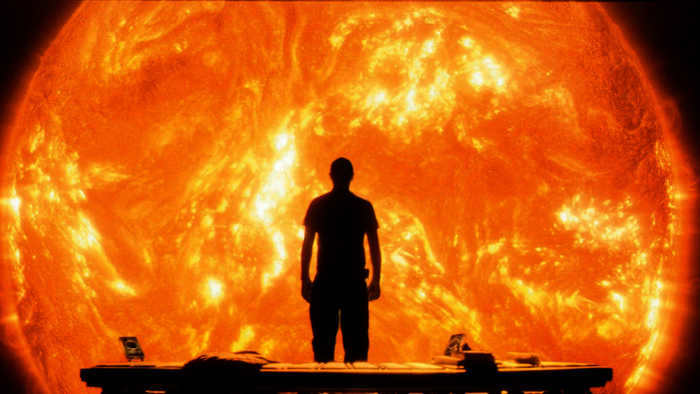
Imagine you’ve had a tough day at work and you return home in the evening, take a deep breath, contemplate your options, and entertain the idea of annihilating humanity. Don’t worry, we’ve all had those thoughts before.
However, if you’re going to carry out such a plan, you need to get creative. Nuclear war, zombie invasion, or another bubonic plague pandemic would be quite effective, but also somewhat mundane. It would be far more impressive to take decisive action on a global scale, such as extinguishing the sun. And all it takes is ordinary water.
Just imagine the sun’s reaction when it discovers your ingenious plan.

It is common knowledge that water can be used to extinguish fires. When water comes into contact with a fire, it evaporates, which cools down the fuel. Once the temperature of the fuel drops below its ignition point, the fire is extinguished. Additionally, water vapor displaces oxygen from the fire, causing the combustion reaction to cease without an oxidizer.
However, the Sun, similar to all other stars, does not undergo combustion in the traditional sense of the term. The Sun is composed of gas that is heated through the nuclear fusion reactions occurring within its core. As a result of the immense pressure from the outer layers, hydrogen within the Sun transforms into helium, thereby emitting a tremendous quantity of energy. This energy heats up the gas, causing the star to emit light.
An example of a prominence on the Sun. Image: NASA / SDO / AIA / Goddard Space Flight Center
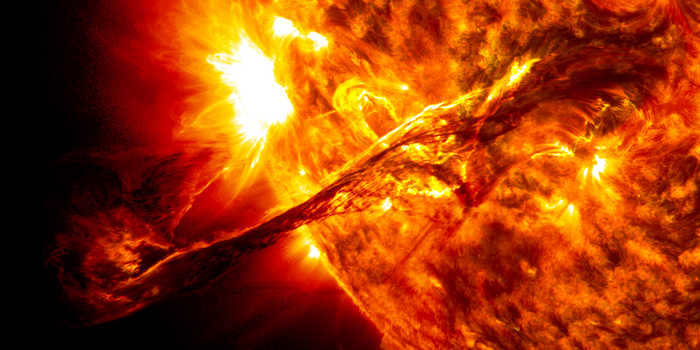
However, we will still attempt to conduct an experiment by attempting to pour water onto the Sun – simultaneously, we will determine whether it will sizzle or not.
In space, there is a substantial amount of water available – the key is knowing where to find it. There are planets that consist predominantly of water. These planets, known as super-Earths, are larger than our resilient Earth but smaller than Uranus. Although, given the composition of these celestial bodies, it would be more logical to refer to them as superwaters, NASA scientists have their own terminology.
In the artist’s depiction, Gliese 1214 b can be seen next to its star. Image: ESO / L. Calçada
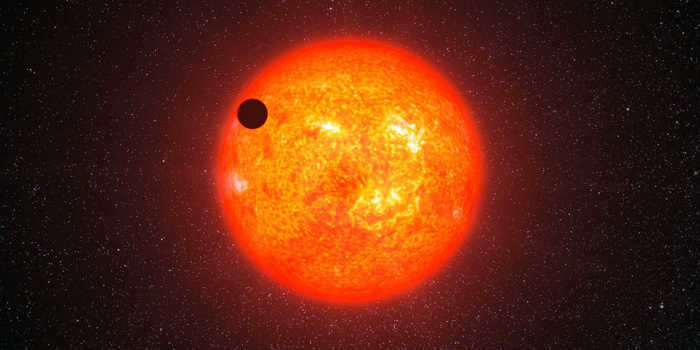
Let’s consider Gliese 1214 b. It has a size that is approximately 2.7 times that of Earth and a mass that is nearly seven times greater. Compared to the Sun, it may seem insignificant, weighing only 332,940 times more than our planet. However, this doesn’t prevent us from taking numerous watery worlds like Gliese 1214 b and bombarding the Sun with them to observe its reaction.
Renowned physicist Randall Munroe, known for his book “What if. Scientific Answers to Absurd Hypothetical Questions”, enlightens us on the outcome of our experiment. When we inundate the Sun with streams of H2O, it will not extinguish – instead, the star will intensify its brightness.
Why not extinguish a fire with gasoline or another unconventional method?

Speaking of whether the Sun will make a hissing sound or not: it won’t, because there is no material in space that can transmit sound waves. However, if you had the ability to perceive radio waves with your ears, you would be able to hear the sound of the Sun. Scientists at NASA and Stanford University have converted data collected by the SOHO radio telescope into an audio format that can be heard by humans. The following is the result of their work.
Isn’t that terrifying? I failed to mention: to fully comprehend the situation, you must have the recording blaring at 100 decibels nonstop – it’s akin to attending a rock concert. It’s similar, but louder, to the sound the submerged Sun would emit if we were capable of hearing it. Fortunately, we cannot.
Therefore, as you pour water into the Sun, the Sun will gradually expand and its internal processes will undergo alterations. Consequently, when you introduce such a large quantity of liquid into the star that it becomes 1.7 times more massive, the hydrogen-helium fusion within the celestial body will transition to the CNO cycle (carbon-nitrogen-oxygen).
What amount of water will be needed for this? Approximately 3.4 × 106 liters, something similar to that. Christopher Baird, a physicist from West Texas State University, explains that if the mass of the Sun is doubled, it will release 16 times more energy and shine 16 times brighter. The color of the star’s glow will change from yellow to a bluish shade.
The solar wind, along with the atmosphere, will blow away life on Earth, and the surface will be sterilized by X-ray and ultraviolet radiation.

In this scenario, the lifespan of the Sun will be significantly diminished: a mere few million years instead of the anticipated 5.4 billion. This is due to the fact that the more luminous a star, the more rapidly it depletes its nuclear fuel.
This is a notable revelation, but as you comprehend, it is still an excessively lengthy duration to endure. Thus, let us continue to pour water onto the Sun.
Fascinating detail – sunspots on the Sun contain water in the form of vapor, and there is a considerably larger quantity of it present there than on Earth. NSO / NSF / AURA
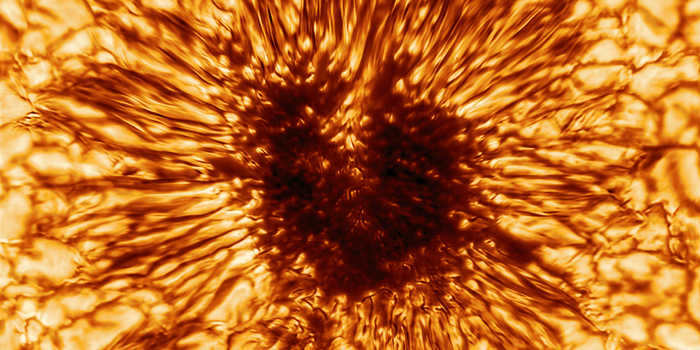
When we add an excessive amount of liquid to the Sun, causing its weight to increase by about 3.3 times, an intriguing phenomenon occurs. Due to the immense pressure exerted by the outer layers, the Sun undergoes a collapse, transforming into a black hole with a radius of approximately 19.5 kilometers. This black hole, which is currently the smallest one known to the scientific community, can be found in the constellation of Ascendant.
At this point, there is no need to continue pouring liquid into the Sun. Enlarging the black hole is unnecessary, as it already emits X-rays as it absorbs matter.
Therefore, once the Sun transforms into a compact black hole, the Earth will commence its gradual cooling process. According to the calculations conducted by physicist Marco Kirko from Cornell University, it is estimated that it will require approximately two months for the remaining thermal energy from the planet’s surface to dissipate into the vastness of space.
Now, you can breathe a sigh of relief as the objective has been successfully accomplished. The consumption amounted to a total of 6.6 × 10³º liters of water.
P.S.: A heartfelt appreciation goes out to all the readers, subscribers, and supporters who generously contribute by liking this content and providing financial support via the following link: https://pay.cloudtips.ru/p/9c59405f. Wishing everyone a delightful mood and an extraordinary day! Until we meet again.

Does tomato juice have a better taste in an airplane compared to on the ground?

There is a belief that tomato juice develops a stronger taste during an airplane journey, which is why it is consumed more frequently on board than in everyday life. We set out to investigate whether there is scientific evidence to support this notion.
LL Spoiler: Due to alterations in taste perception caused by low blood pressure, as well as psychological factors, the flavor of tomato juice on an airplane may indeed appear more intense and vibrant.
There have been numerous reports in the media and on travel websites about the exceptional popularity of tomato juice on commercial flights. The demand for this drink among passengers has also been discussed in the travel and tourism industry, as well as on gastronomic resources. Flight attendants have even mentioned the high demand for tomato juice among passengers. Yulia Mikheeva, a flight attendant at S7 airline, told The Village that tomato juice is ordered about 30 percent more often than other juices and it tends to run out quickly. This is why they stock more tomato juice on board, sometimes taking 15 tomato juices for every ten packs of apple and orange juices. However, she notes that the preference for tomato juice is not absolute and can vary depending on the destination. When flying to the East, passengers tend to prefer apple and orange juice, although she cannot explain the reason behind this. In Europe, the West, and Russia, tomato juice is the most popular choice. The importance of tomato juice as part of the onboard menu is highlighted by a past incident in 2018 when American airline United Airlines decided to remove tomato juice from its menu. This decision caused outrage among passengers and eventually resulted in tomato juice staying on the menu.
Until the 1920s, tomato juice was not widely consumed due to a lack of technology for mass production and a limited market. Culinary historian and food researcher Andrew Smith explains the origins of tomato juice as follows. Two brothers from Indiana modified an ice cream machine to extract a thick and flavorful juice from tomato pulp. Heinz and Campbell Soup recognized the potential and were the first to commercially produce the beverage. Following the end of Prohibition, tomato juice became a key ingredient in the popular Bloody Mary cocktail. In the 1930s, pioneering aviator Amelia Earhart, the first woman to fly across the Atlantic Ocean, revealed in a radio interview that tomato juice was her preferred in-flight beverage and served as a meal replacement in those circumstances.
In 2010, Lufthansa, the German airline, made an interesting observation about its passengers’ beverage preferences. They found that during the year, passengers consumed 53,000 gallons (over 200,000 liters) of tomato juice, making it the second most popular drink on board after beer, which consumed 59,000 gallons (223,000 liters) in the same period. This discovery led Lufthansa to conduct a study to investigate why tomato juice is so appealing to passengers.
To carry out this study, Lufthansa enlisted the help of scientists from the Fraunhofer Society for the Promotion of Applied Research, the largest association of applied research institutes in Europe. They transformed the fuselage of a decommissioned Airbus A310-200 airplane into a flight simulator. The scientists covered the portholes with images that resembled what passengers see during a flight, installed speakers that reproduced the sounds of an airplane, and incorporated special devices to simulate the shaking of a seat during flight. They also recreated the same pressure, humidity, and air temperature that passengers experience on a typical flight.
Volunteers were then invited to experience this simulated flight cabin and were offered various in-flight food options. The study found that the perception of sour taste remained the same “at altitude,” but sweet and salty flavors lost about 20% of their intensity. Dr. Andrea Burdak-Freitag, one of the scientists involved in the study, compared the taste perception on a plane to the sensations experienced during a cold. She explained that at normal blood pressure, tomato juice is perceived as earthy and musty, but at low cabin pressure, volunteers described it as more pleasant, fruity, and with a distinct sweet and refreshing taste.
According to scientific research, it has been found that there is a change in the perception of individual tastes at higher noise levels and at high altitudes, where the pressure is lower. Specifically, sweet and salty flavors are perceived as less intense, while umami flavor is perceived as more intense, and bitter and sour flavors stay the same. It is interesting to note that the researchers did not specifically test tomato juice, which is known to have a strong umami flavor. However, it can be presumed that the change in taste perception would have also affected tomato juice. Psychologists also point out that the use of tomato juice on airplanes has become somewhat of a ritual for many passengers. This may lead people to choose tomato juice more frequently, not only because of their subjective taste preferences, but also because it has become a customary practice.

Our conclusion: most probably correct
The Earth is a massive entity that cannot be weighed directly. So how did scientists determine the Earth’s mass? How is the mass of celestial bodies in space calculated?
1.
Please rephrase the text, making it unique and using the English language, while preserving the HTML markup:
1.
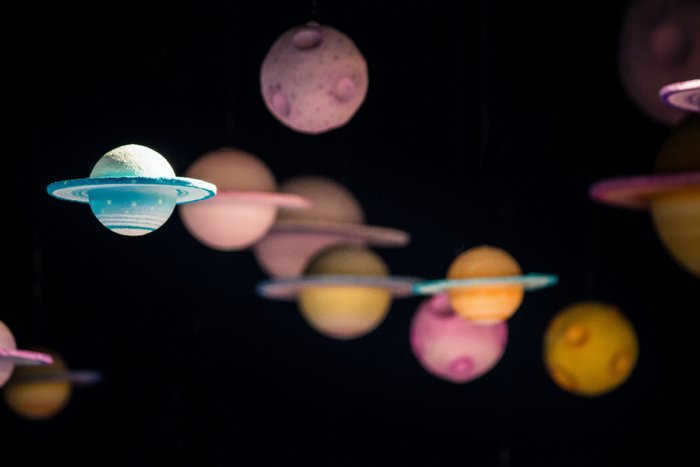
Exciting physics
There are two methods for determining the mass of Earth: utilizing a barometer and mathematical computations, or analyzing neutrino particles.
The barometer and Newton’s laws
A technique that has been employed since the 18th century. Newton’s second law (F=mg) and the law of universal gravitation (F=G*m*M/R^2) are utilized for calculation.
F represents the gravitational force of the Earth on the barometer, G is the gravitational constant coefficient, R is the planet’s radius, m is the instrument’s weight, and M is the planet’s weight.
Additionally, the mass of Earth is determined using the formula: M = g*R^2/G, where g is the acceleration of free fall.
2.
Please rephrase the text, making it unique, using the English language and preserving the HTML markup:
2.
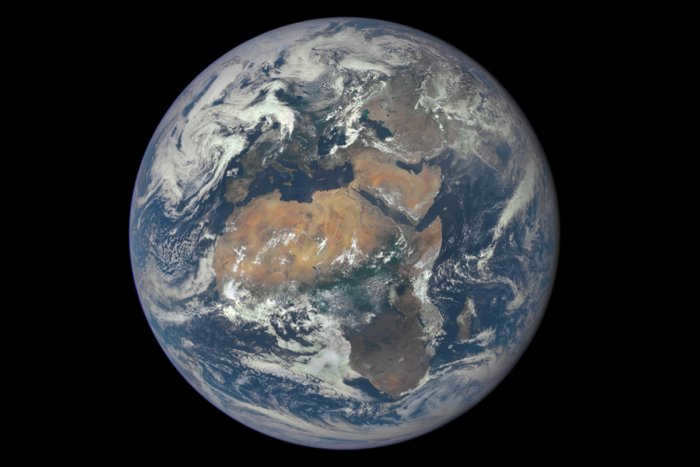
A photograph of our planet, Earth, was taken on July 29, 2015 from the Deep Space Climate Observatory spacecraft.
The measurement of Earth’s radius has been known since ancient times. This remarkable discovery was made by Eratosthenes, a Greek mathematician, in the 3rd century BC.
Eratosthenes carefully observed the summer solstice, when the sun reaches its highest point in the sky, and at 12 o’clock noon casts the shortest shadow of the year.
The mathematician carefully examined a nearby obelisk, measuring both its shadow and its actual size. After calculating all the angles, he repeated the process in a neighboring town. These calculations led him to determine that the circumference of the Earth was 38.5 thousand kilometers. In modern times, scientists have reevaluated this measurement using a similar method and determined that the Earth’s circumference is actually 40,000 kilometers.
As the Earth is not a perfect sphere, its radius has been determined to be 6371 kilometers.
The most challenging aspect was finding the value of the gravitational constant coefficient. To accomplish this, researchers used a one-ton lead ball and observed the force with which it attracted the barometer.
By plugging all of these values into the equation, the scientists were able to calculate that the Earth’s weight is six septillion kilograms, or 6^24 kilograms.
Neutrinos
These are minuscule subatomic particles that are released by the Sun. They traverse through the planet.
3.

Spanish scientists established a laboratory at the South Pole, patiently waited for the Sun to be positioned at the North Pole, and successfully captured neutrinos from the opposite side.
This experiment may seem astonishing, however, by analyzing the velocity of these particles as they traversed through the Earth, the physicists were able to determine the planet’s density and subsequently its mass.
How do we measure far-off planets?
The masses of distant planets are estimated through calculations. The orbits of these planets, along with the orbits of their satellites, and the gravitational interactions between them, serve as the foundation for these calculations.
The masses of stars are determined by evaluating their brightness. It is believed that the more luminous a celestial body is, the greater its mass. The luminosity of a star provides insight into its chemical composition, as well as its approximate density and weight.
Science and Technology November 13, 2020 1,548 views
In 1798, the renowned English scientist Cavendish (1731-1811) became the first person to calculate the mass of planet Earth. He utilized Newton’s law of gravitation and introduced a basic apparatus known as a torsion scale to measure the Earth’s weight.
Henry Cavendish was the first to calculate the mass of planet Earth using torsion scales.
The principle of these scales forms the foundation of the modern gravity variometer. This device is incredibly sensitive and is widely employed in geological exploration.
Dimensions of the Earth
Earth is a relatively large celestial body. The Earth’s dimensions are as follows:
- Polar radius – 6,357 kilometers,
- Equatorial radius slightly over 6,378 kilometers,
- Polar diameter 12,714 kilometers,
- Equatorial diameter 12,757 kilometers,
- Length of the meridian – a circle drawn through both poles, 40,004 kilometers;
- Length of the equator 40,075 kilometers;
- Out of the total size of the Earth, approximately 148 million kilometers is made up of land.
- The seas and oceans cover about 362 million square kilometers of the Earth’s surface.
- The Earth has a volume of 1 billion 83 billion cubic kilometers.
- The density of the Earth is 5.5 times that of water.
- The weight of the planet Earth is approximately 6,000,000,000,000,000,000,000,000,000,000,000,000,000,000,000,000,000,000,000,000,000,000,000,000 tons.
If we were to load the entire mass of the Earth into cars, with each car capable of carrying 50 tons, we would need a train that is 8 billion times longer than the distance from the Earth to the Sun. This illustrates just how immense and heavy our Earth really is!
Earth’s Density
The typical density of our planet Earth is four times higher than the average density of the Sun and 5.5 times denser than water. Certain metals found deep within the Earth are even denser. For instance, platinum is 21 times denser than water. Nevertheless, platinum’s density is not considered extraordinary when compared to some other celestial bodies in the universe.
The density of planets in comparison
Sirius has a density that is 40,000 times greater than that of water. If you were to fill a matchbox with the material from this star and place it on a scale, you would need to add 15 people on the other scale to balance it out. Another small star, discovered by astronomer Kainer, has an even more remarkable density.
The substance of this tiny star is 10,000 times denser than platinum. A matchbox filled with this material would weigh approximately 50 tons! Imagine trying to fit that box in your pocket! However, it is worth noting that there are also stars with much lower densities, around 100 times less dense than the air around us. This just goes to show the vast range of densities among stars.
The Principle of Universal Gravitation
Once the realization that our planet is confined within the vast expanse of space dawned upon us, the natural question arose: what is it that keeps the Earth firmly anchored in its orbit? What force prevents it from careening off into the void? This inquiry remained unanswered for a considerable period of time.
For centuries, the enigma remained unsolved, perplexing countless minds. Eventually, however, the brilliant intellect of Isaac Newton, renowned mathematician, engineer, physicist, and astronomer, unveiled the principle of universal gravitation. Newton postulated that all celestial bodies in the cosmos exert a mutual attraction towards one another, thus establishing a bond that governs their movements and interactions. (For further details, refer to the Law of Falling Bodies).
Isaac Newton is credited with the discovery of the law of universal gravitation.
As a result, in order for all the planets to remain in their orbits, the central body of the system, around which all the planets (including our Earth) revolve, must possess an immense mass. In fact, the mass of the Sun – the central body of the planetary system – is 750 times greater than the combined mass of all the planets and their satellites, and more than 330,000 times greater than the mass of the Earth.
The Sun’s gravitational pull is what keeps the planets in their orbits. Without the force of the Sun’s attraction, a planet like P, moving in the direction of PC, would continue moving in a straight and uniform path (according to the law of inertia). In just one second, it would move from point P to point K and eventually exit the solar system.
Contrary to this, if the celestial body only experienced the attraction of the Sun, it would travel from point P to point L within the initial second. However, due to the dual influences of the Sun’s attraction and the body’s own motion, it will follow the diagonal PA of the parallelogram formed by these actions.
As a result, after the first second, the planet will not be located at point K or point L, but will instead move diagonally to point A. By applying the same reasoning, we can deduce that the planet will reach point B in the second second, point C in the third second, and so on.
Here, it becomes evident how a force in the vast and silent expanses of space continuously pulls our Earth and other planets around the Sun without any jolts or tremors. Many of you may have experienced the joy of twirling a rubber band with a pebble attached to the end during childhood.
While the rubber band is spinning, it is constantly under tension. However, once you stop spinning it, it immediately contracts and the pebble moves closer to your hand.
If the rubber band were to suddenly break free from your hand, the pebble and the rubber band would fly apart. The same principle applies to planets if the Sun were to suddenly stop attracting them.
In ancient times, people had their own beliefs about the size, shape, and mass of the Earth. According to the ancient worldview, the Earth was thought to be shaped like a hemisphere or a “flat plate” supported by three whales or massive elephants. At the base of this cosmic pyramid stood a giant turtle. This common belief in ancient times was that the Earth was flat and had an edge.
There were notable advancements in understanding the Earth’s shape and weight during the Middle Ages. Giordano Bruno, who was tragically persecuted by the Inquisition, was the first to propose that the Earth is a sphere. Additionally, Magellan, a renowned explorer, provided empirical evidence to support the spherical Earth theory through his circumnavigation of the globe.
What is the weight of the Earth in kilograms?
The weight of the Earth was first attempted to be determined by the ancient Greek scientist Erastostosthenes. By measuring the shadow with a stick in different cities of Greece and comparing the results, Eratostosthenes derived a formula to calculate the Earth’s volume.
Isn’t that interesting!
These pages provide information on various topics such as: the weight of a cloud, the weight of a tank, the weight of a brain, the weight of an egg, and a Weight Calculator.
Now we just need to utilize the equations and determine the weight of the Earth. The mass of the Earth was initially measured by Scottish scientist Dr. N. Makelin in 1774, resulting in a value of 5.879 sextillion tons. However, this figure has slightly increased over time to 5.976 sextillion tons.
The weight of the Earth is approximately 5.976 sextillion tons.
Nevertheless, these discrepancies do not imply any inaccuracies in the calculations made by the medieval scientist. In fact, these calculations are remarkably precise, and the discrepancy can be attributed to the continuous accumulation of cosmic dust, which causes the Earth’s mass to increase by approximately 30,000 tons every year!
Incidentally, utilizing the fundamental principle of gravity, you have the capability to easily determine the weight of the Earth. All one has to do is suspend a petite weight from a thread and meticulously measure its precise position. In close proximity, position a metric ton of lead. The mutual attraction between these two entities will result in a slight displacement of the small weight – a mere 0.00002 mm. Although this value may seem infinitesimal, it can be utilized to compute the Earth’s mass. Simply ascertain the gravitational force of the Earth exerted upon the weight, as well as the attractive force between the small weight and the lead. By considering the relative disparity obtained, one can calculate the mass of the Earth.
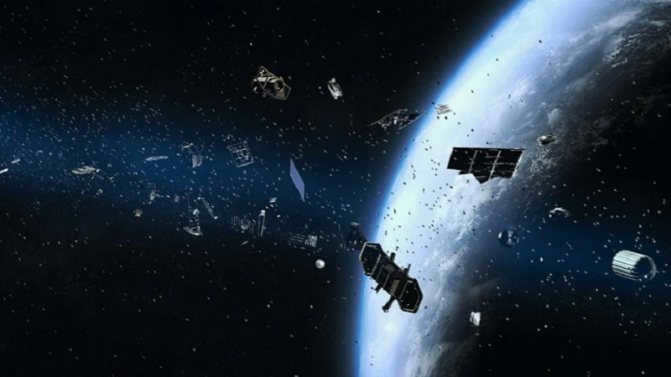
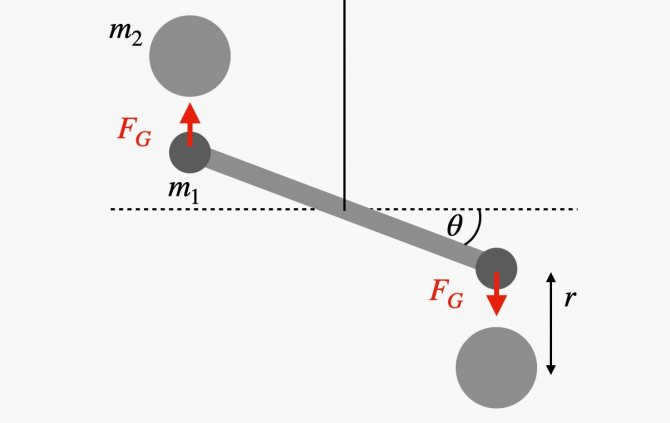

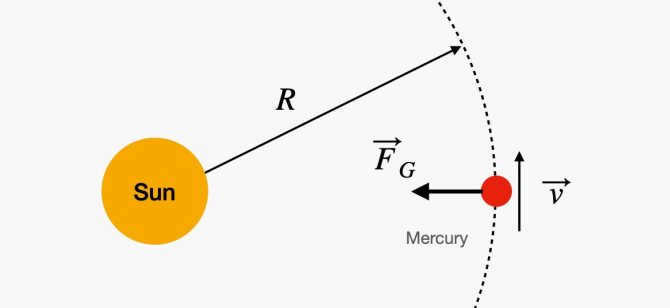


All objects possess unique properties, including gravity and weight. The inquiry regarding the weight of planet Earth lacks meaning. At first glance, this notion may seem peculiar, but it is actually quite logical. Our planet is suspended in space, experiencing free fall, where the concept of weight becomes irrelevant. However, the quantity of matter it contains is consistently present and appears to be substantial.
Have you had the opportunity to observe: What is the temperature on Venus?
To determine the mass of the Earth, the most straightforward method is to utilize the principle of gravitational dependence. This involves suspending a small weight on a thread and introducing a significantly larger object in its vicinity. As per Newton’s law, the light weight will deviate from the vertical position and the distance between the two bodies will experience a slight decrease. By measuring this reduction, we can compute the source of the planet’s gravitational pull, given that the acceleration due to Earth’s gravity is a known value of 9.81 m/sec2.
It is common knowledge that our planet is made up of different materials. Therefore, here is an approximate breakdown of the Earth’s total mass (in descending order):
- The mantle is a layer composed of iron, calcium, and magnesium silicates. It has a mass of approximately 4.043 x 1024 kg.
- The core, which consists mainly of iron and nickel, accounts for about 1.93 x 1024 kg.
- The Earth’s crust, where humans reside, weighs approximately 0.026 x 1024 kg.
- The hydrosphere, which includes all the Earth’s water, makes up about 0.0014 x 1024 kg.
- The atmosphere, the gaseous envelope around the planet, occupies roughly 0.0000051 x 1024 kg.
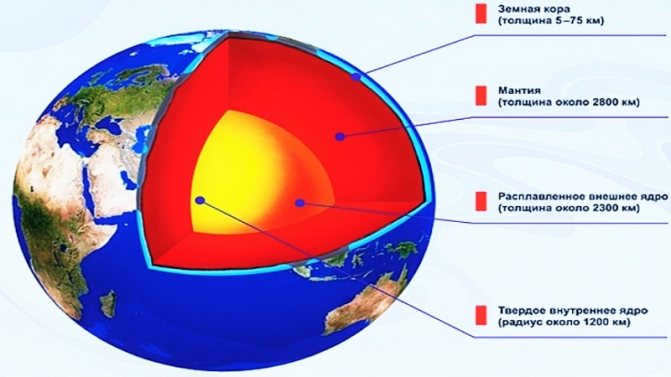
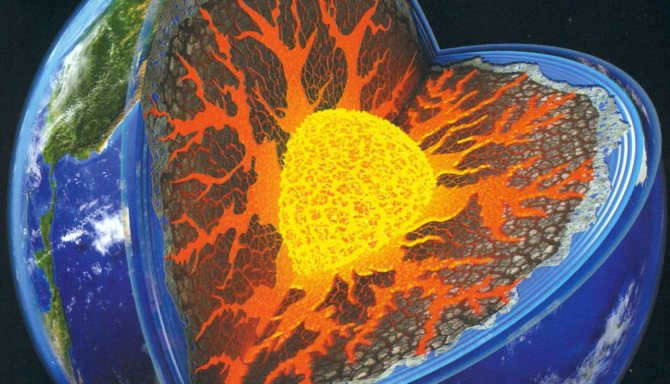
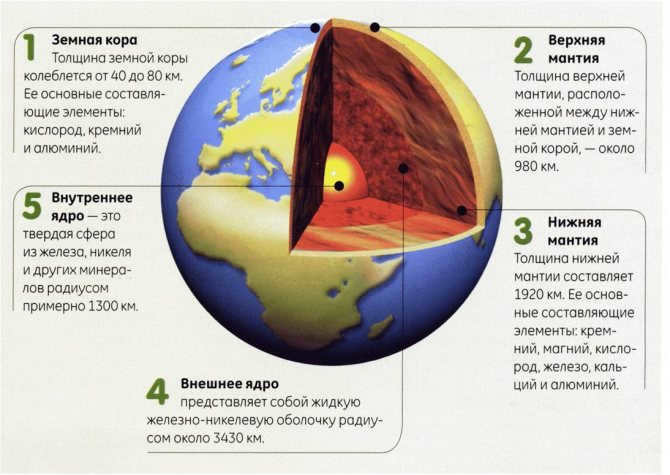

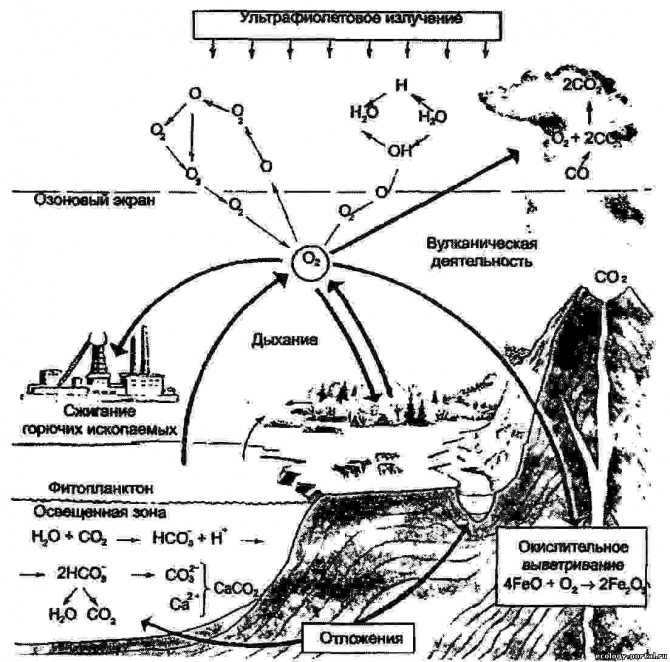

According to Newton’s theory of gravitation, we can assume that the substance of the spheres is concentrated at their centers in order to calculate the gravitational interaction between them. To determine the mass of the Earth, we can use Newton’s classical theory of gravitation:
F represents the force of attraction between the bodies;
G represents the gravitational constant, which is equal to 6.67408(31)-10-11 m³/(kg-c²);
m1 and m2 represent the respective measures of inertia of the interacting bodies;
Also, check out: Basic concepts of ecology and economics and the interrelation of economic and environmental problems.
R represents the distance between the bodies.
If we compare the Earth to a 1 kg ball, the force of interaction between them is 9.8 kg × m/sec2. The Earth has a radius of 6.4 million meters. By plugging these values into the given formula and doing some simple calculations, we find that the result is 6 × 1024 kg, which is the mass of our planet.
What is the weight of the Earth compared to other planets?
The Earth is the largest planet in the Earth group. Mars, for example, weighs about 0.108 times the weight of Earth, Venus weighs 0.815 times, and Mercury weighs 0.055 times.
However, the gas giant planets are much larger and heavier than Earth. If we compare it to Jupiter, our planet is 317.8 times lighter – but Jupiter is far from any other planet in the solar system. For comparison, Saturn is 95.1 times heavier than Earth, Neptune is 17.2 times heavier, and Uranus is 14.5 times heavier.
So now we know the weight of the Earth and how it compares to other planets in the solar system.
You don’t need to possess scientific knowledge to understand the basic positioning of our planet – each day, you have the opportunity to observe the Sun, the celestial body around which the Earth revolves. During nighttime, the Moon, our planet’s sole and fifth largest satellite in the entire solar system, becomes visible. Additionally, on clear summer nights, the Milky Way gleams brilliantly – the visible segment of the galaxy within the Orion arm, where our Sun journeys alongside millions of other stars.
The precise coordinates of our planet within the Universe are as follows:
- Planetary system: Solar
- Local interstellar cloud.
- Galactic arm of Orion
- Galaxy: Milky Way
- Galaxy cluster: Local group
- Galaxy Supergroup: Local Supergroup (Virgo)
- Galaxy Supergroup: Laniakea
- Wall: Pisces-Keith supergroup complex.
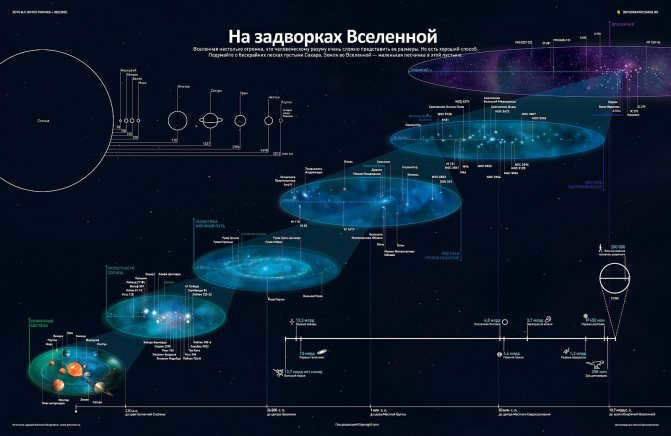
Discover what these designations signify and gain insights into the appearance of our home from a distance by reading the article on the vast structure of the Universe. However, there are numerous other distinctive aspects of our planet’s location that astronomers often overlook. And it’s not without reason – as the old saying goes, the devil is in the details. So, let’s explore what lies in close proximity to Earth – so near that we often fail to acknowledge it.
Earth’s Nearest Environment
The Moon is the space object that is closest to our planet Earth. It is positioned at a distance of “merely” 384,400 kilometers, which is equivalent to 9.6 times the circumference of the Earth! This distance is already considerable for a human being. The journey to the Moon, with controlled navigation, required a duration of 3 days, 3 hours, and 49 minutes. Conversely, the New Horizons spacecraft accomplished the approach to our satellite in just 8 hours. However, it is essential to bear in mind the objectives of these missions – unlike American astronauts, the New Horizons probe did not need to decelerate for a “moon landing.”
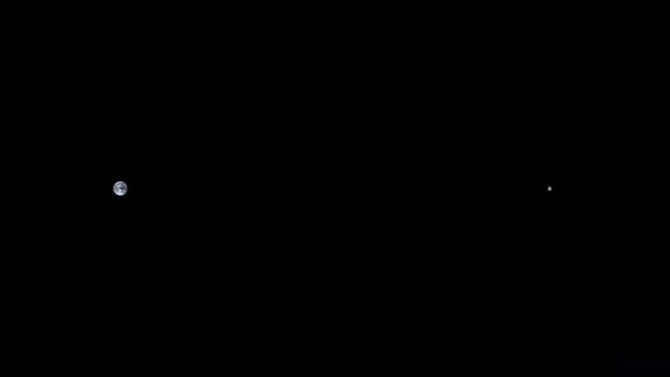
Despite being a satellite of the Earth, the Moon is situated at a considerable distance from it.
In every aspect, the Moon is an extraordinary satellite. Its history with the Earth is characterized by proximity and intensity: the parent planet collided with our planet, resulting in a massive chunk being dislodged – thus giving birth to our Moon. As it evolved alongside the Earth, it acquired its distinctive appearance, captivating humans for over a millennium.
Are there any other natural satellites besides the Moon orbiting Earth? The truth is, there are thousands of them. Our planet is surrounded by a multitude of dust particles and small rocks that continuously orbit around it, and their numbers are increasing each year. However, what the reader is likely interested in are larger objects – perhaps not as large as the Moon, but at least the size of a substantial rock.
Unfortunately, there are no other such objects. The only exception is quasi-satellites – celestial bodies whose orbits come very close to Earth in certain sectors of their motion. The largest of these quasi-satellites is the asteroid Cruithne, which has a circumference of 5 kilometers. Cruithne’s orbit around the Sun is highly elongated, bringing it close to Mercury at its closest point (perihelion) and reaching Mars at its farthest point (aphelion) – but it cannot be considered a true satellite. Nevertheless, it comes close enough to Earth and regularly changes its direction of motion.
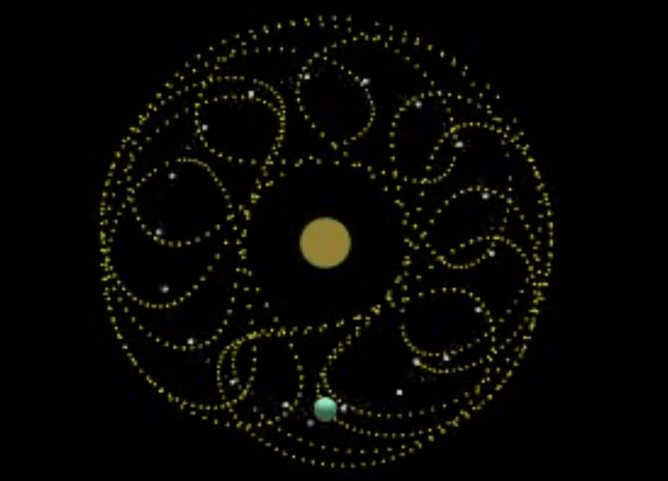
The annual motion trajectory of Cruithne
An issue with Cruithne, and many similar quasi-satellites, lies in the instability of their orbits. These asteroids are not only influenced by Earth, but also by other celestial bodies such as planets. Consequently, they can either become fully-fledged satellites of Earth or collide with it.
The latter scenario, although unlikely, poses a significant danger. Take, for example, the recent 17-meter meteorite in Chelyabinsk, which caused extensive damage and incurred millions of dollars in losses. Now, imagine a collision between such a meteorite and an asteroid like Cruithne. Even if it were to fall into the ocean, the resulting waves would reach heights of 500 meters and cover a distance of 600 kilometers. Additionally, a rumble with a noise level of 60 decibels, comparable to a busy road during morning rush hour, would be audible even on the opposite side of Earth.
Artificial Satellites
However, it is humans who have achieved the most in populating the Earth’s orbit. Since the start of the space era on October 4, 1957, with the launch of the first artificial satellite, Sputnik-1, in the USSR, many years have passed – and now the Earth is surrounded by a whole cloud of over 18 thousand satellites.
Near-Earth satellites serve various purposes – from scientific research and communication services to orbital weaponry. However, it is important to note that an artificial satellite is generally defined as any object launched by humans into Earth’s orbit. Based on this criteria, Earth’s artificial satellites are divided into two main categories: proper satellites and space debris.
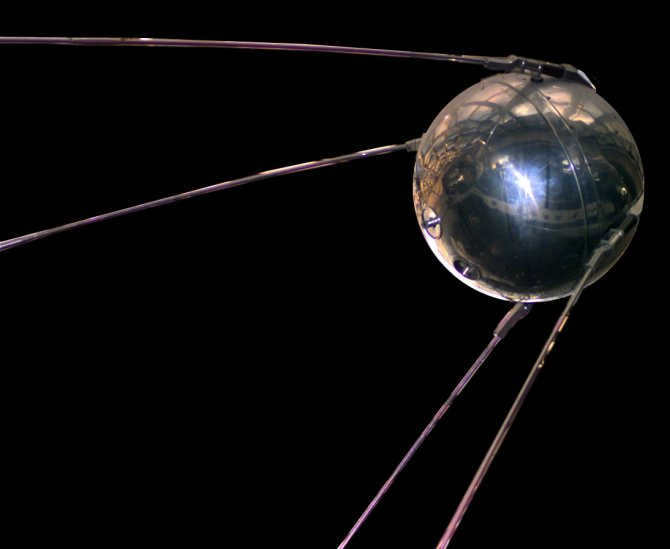
An object that is capable of performing actions in orbit is commonly referred to as a satellite. This definition encompasses a wide range of devices, including manned orbital stations equipped with scientific instruments, as well as amateur radio installations that can only transmit their presence in the radio frequency range. As of now, there are approximately 6 thousand satellites in total, with only around 600 of them actively operating. The remaining satellites are essentially space debris, categorized as “conditionally functional.”
Communication satellites, meteorological satellites, and space stations are well-known and widely used. They serve various purposes, such as providing telephone and Internet access globally, tracking air masses, and even monitoring the growth of crops. These satellites have become an essential part of our lives, enabling us to stay connected and informed. For instance, television relay and geo-navigation satellites have made a significant impact worldwide. Even in remote areas like Liberia, where infrastructure is limited, people can still enjoy satellite television.
As technology advances, the cost and efficiency of satellite services are improving. However, there is still one issue that persists – slowness. This is primarily due to the laws of physics. In order for a communications satellite to remain in geostationary orbit and stay fixed in one position in the Earth’s sky, it must be positioned at an altitude of approximately 37,000 kilometers above the Earth’s surface. The signal must travel to the satellite, undergo processing (which often includes encryption and compression due to communication protocols), and then travel back to the Earth.
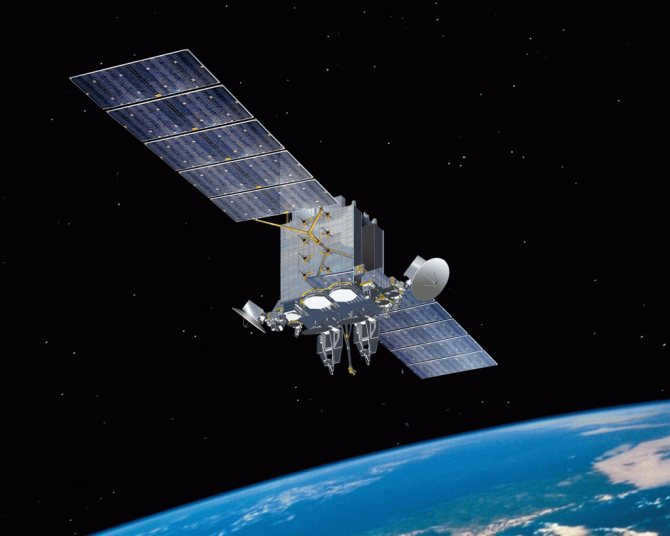
If you compare the velocity of the electromagnetic wave to the velocity of light, the typical latency is 2-3 seconds – not significant if you’re merely watching a YouTube video, but a hindrance when you’re on the phone. Therefore, when your navigation system takes an extended period to acquire a GPS signal, do not immediately blame the manufacturer – it is most likely due to the inevitability of the laws of physics.
The issue of end-of-life satellites in orbit is directly linked to the challenges faced in the history of space exploration. Initially, both governments and private companies focused on developing technologies that would allow for the launch of multiple satellites at a reduced cost. This led to the creation of PocketSats, which could be delivered into orbit for a mere $10,000. This new affordability meant that individuals could now have their own personal satellite communication stations, potentially replacing the purchase of a new car. However, the concern of disposing of satellites from orbit only arose after this development. In the present day, most orbital spacecraft are designed to safely descend from orbit and burn up in the atmosphere once their resources have been depleted. However, the number of “environmentally friendly” satellites remains limited.
Nonetheless, a significantly larger predicament exists in the form of the commonly referred to as “classic” space debris – comprising of space rocket stages, spacecraft debris, and solid dust – which includes slag from solid-fuel upper stages. The Earth’s orbit currently hosts over 13 thousand items of this debris. Do you believe this quantity to be insignificant? I implore you to examine a space debris map, which reveals a layer of debris uniformly distributed around the Earth, posing a substantial hazard to functioning satellites.

